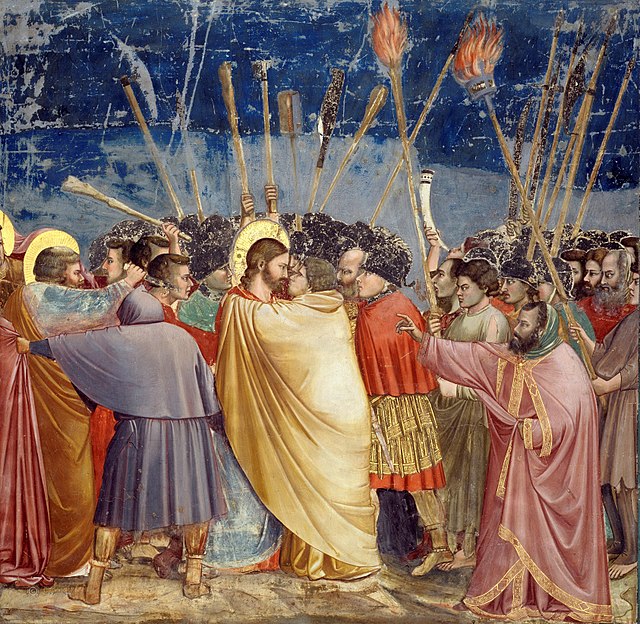Introduction of The Kiss of Judas

In the annals of biblical history, one incident stands out as a prime example of treachery and betrayal: the Kiss of Judas. This act, performed by one of Jesus Christ’s disciples, Judas Iscariot, has become synonymous with acts of disloyalty and deceit. In this article, we will delve into the story of Judas Iscariot, explore the events leading up to the betrayal, examine the motives behind it, and discuss the historical and symbolic significance of the Kiss of Judas.
The Background of Judas Iscariot

Judas Iscariot, also known as Judas from Kerioth, was one of the twelve disciples chosen by Jesus Christ. He was entrusted with the responsibility of managing the disciples’ finances and was known for his greed. Despite being a close companion of Jesus, Judas carried a darker side that eventually led to his infamous betrayal.
The Last Supper and the Betrayal of The Kiss of Judas
The Last Supper, a significant event in Christian tradition, marked the final gathering of Jesus and his disciples before his crucifixion. During this meal, Jesus revealed that one of his disciples would betray him. The news shocked the others, who began questioning their loyalty. Unbeknownst to them, Judas had already struck a deal with the religious authorities to hand Jesus over to them.
Motives behind the Betrayal of Judas

Various theories attempt to shed light on the motives behind Judas’ betrayal. Some suggest that he was motivated by greed, as he accepted thirty pieces of silver as payment for his treachery. Others argue that he grew disillusioned with Jesus’ teachings and wanted to force his hand to reveal his true power. Regardless of the exact motivation, Judas’ actions had far-reaching consequences.
The Kiss of Judas

The incident took place during the Last Supper, which was the final meal Jesus shared with his disciples before his crucifixion. Jesus knew that one of his close followers would betray him, and he revealed this information to his disciples during the meal. Judas, driven by his own motives, had already struck a deal with the religious authorities to hand Jesus over to them.
In the Garden of Gethsemane, where Jesus went to pray after the Last Supper, Judas approached him with a group of soldiers and religious leaders. As a sign of identification, Judas greeted Jesus with a kiss on the cheek, which was a common custom at the time to show respect or friendship. However, in this context, it became a symbol of betrayal.
The kiss served as a signal to the authorities, indicating which person among the disciples was Jesus. Jesus was subsequently arrested and taken into custody, leading to his trial and eventual crucifixion.
The Kiss of Judas holds significant symbolic and historical importance. It represents the act of betrayal by a trusted companion and underscores the complex interplay between human choices and divine purpose. The story of Judas Iscariot’s betrayal has been interpreted in various ways throughout history, reflecting themes of loyalty, greed, forgiveness, and the role of personal accountability.
Overall, the Kiss of Judas is a pivotal moment in the narrative of Jesus’ crucifixion, highlighting the profound consequences of betrayal and the ultimate sacrifice that Jesus made for humanity.
Aftermath: Arrest and Crucifixion of Jesus
Following the betrayal, Jesus was arrested, put on trial, and ultimately sentenced to death by crucifixion. The Kiss of Judas not only facilitated Jesus’ capture but also played a significant role in the events that unfolded afterward. It marked the beginning of the end for Jesus’ earthly journey and set in motion the events that would lead to his crucifixion.
The Historical Impact of Judas Iscariot’s Betrayal

- Fulfillment of Prophecies: The betrayal of Jesus by Judas Iscariot fulfilled several prophecies found in the Hebrew Scriptures (Old Testament). For instance, the book of Psalms contains prophetic references to a trusted friend who would betray the Messiah. The fulfillment of these prophecies reinforced the belief among early Christians that Jesus was the long-awaited Messiah.
- Sacrifice and Redemption: Judas’ act of betrayal played a crucial role in the sacrificial death of Jesus. According to Christian theology, Jesus’ crucifixion and resurrection paved the way for humanity’s redemption from sin. Judas, unwittingly or not, became an instrument in the divine plan of salvation.
- Divine Providence and Human Responsibility: The story of Judas Iscariot highlights the intricate interplay between divine providence and human responsibility. It illustrates the tension between God’s foreknowledge of events and the free will of individuals. Judas’ betrayal serves as a prime example of how human choices can shape significant historical events.
- Theological Reflection and Moral Lessons: Judas’ betrayal prompted deep theological reflection among early Christian communities. It raised profound questions about the nature of evil, the limits of forgiveness, and the tension between divine sovereignty and human agency. The story of Judas continues to inspire discussions on personal responsibility, repentance, and the complexities of human character.
- Artistic Depictions and Cultural Influence: The Kiss of Judas has been depicted in numerous works of art, including paintings, sculptures, and literary works. Artists throughout history have captured the emotional intensity and moral implications of this pivotal moment. Cultural references to Judas and his betrayal have permeated literature, theater, and popular culture, contributing to the enduring impact of the story.
It is important to note that while the historical impact of Judas Iscariot’s betrayal is significant within Christian tradition, interpretations and perspectives on his character and actions may vary among different religious and theological traditions.
Overall, Judas Iscariot’s betrayal holds historical importance as a key event in the life of Jesus Christ and the development of Christian theology. It underscores themes of divine providence, sacrifice, redemption, and the moral complexities of human choices.
Understanding the Symbolism of Kiss of Judas
The Kiss of Judas carries profound symbolism in religious and cultural contexts. It represents the betrayal of trust, the consequences of greed, and the juxtaposition of good and evil. Judas’ actions serve as a cautionary tale, warning against the destructive power of personal gain and the erosion of loyalty.
The Controversy Surrounding Judas
Throughout history, Judas Iscariot has been a subject of controversy and debate. Some view him solely as a villain, condemning him for his betrayal and subsequent suicide. Others argue that he played a necessary role in the grand plan of salvation and should be seen as a tragic figure rather than a purely malevolent one.
Lessons from the Betrayal of Judas
The story of Judas Iscariot’s betrayal holds valuable lessons for humanity. It reminds us of the dangers of unchecked greed, the consequences of betraying trust, and the importance of personal accountability. It prompts us to reflect on our own actions and the impact they can have on others.
Conclusion
The Kiss of Judas remains an enduring symbol of betrayal and serves as a cautionary tale in biblical history. Judas Iscariot’s treachery, motivated by greed or disillusionment, led to the arrest and crucifixion of Jesus Christ. The event holds profound historical and symbolic significance, reminding us of the consequences of betrayal and the need for personal introspection.



